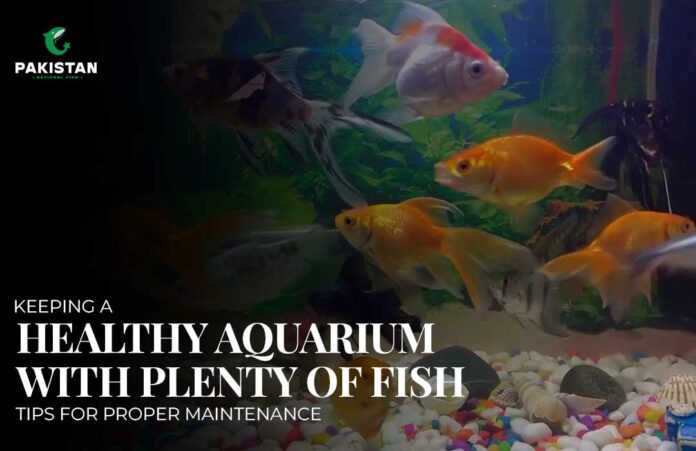Keeping a fish aquarium with plenty of fish is both fun and challenging at the same time. From water conditions right through to feeding, every single aspect requires careful consideration. With the right approach, the possibility of fostering a rich and beautiful underwater environment is entirely achievable.
Now, we have a list with important guidelines on how to maintain the health of your aquarium fish:
- Knowing What Your Aquarium Requires
- Setting Up Water Parameters
- Regular Water Changes
- Selection of and daily adherence to Filtration
- Monitoring Fish Health
- Feeding Best Practices
- Handling and Preventing Algae
Knowing What Your Aquarium Requires
The Different Aspects of Your Aquarium It should also be noted that every aquarium is special in its way depending on the kind of fish put into it, the size of the fish tank, the water supply, plants, etc. To begin:
Select Appropriate Fish: Select the fish that are easy on the temperaments, sizes, and water that need to be put together in the same aquarium. Species from different organizations can share one community tank, while species from the same genus can require special attention when placed in specific tanks.
Cycle the Tank Properly: However, before introducing the fish you should have your aquarium cycle first. This process introduces helpful bacteria that will work out ammonia and nitrite which are poisonous to the fish. Cycling normally lasts between 4 to 6 weeks, helping to make the water safe for aquarium fish.
Setting Up Water Parameters
Fish are sensitive to water quality, so it’s essential to keep parameters stable:
Temperature: Every fish type has a temperature zone that it loves most. Tropical fish are best kept at a temperature of 74-82°F (23-28°C), but, for instance, goldfish need 60-74°F (15-23°C). Ensure that you are using a good heater and thermometer to regulate the temperatures.
pH Balance: Regularly test the pH level. The approximate pH level that most of the preferred fish for freshwater are recommended ranges from 6.5 to 7.5 except for some. To regulate those levels, a pH kit has to be used with pH buffers being incorporated if there is a need to balance some values.
Water Hardness and Salinity: Chloride, bicarbonate, and carbonate should be checked, as well as conductivity, GH, and KH, since different fish have different requirements. Aquaria also requires correct salinity, which can be checked using a hydrometer.
Regular Water Changes
One of the most critical aspects of aquarium care is regular water changes:
Frequency: Change water by about 10-20% on a weekly or every two weeks basis considering the size of the tank and its stocking densities. In tanks that are densely filled with liquids, it may be necessary to review the frequency of changing the absorbers more frequently.
Water Quality: It is advisable not to use chlorinated or hard water in changes. Chlorine or chloramine is present in tap water which is ineffective for fish. Some of these chemicals can be lethal and conditioners help in making the water safe.
Vacuuming Substrate: About water changes, the Electronics Cycler should redesign the hood to incorporate a gravel vacuum for the substrate. In the substrate, there is fish waste and food scraps, and if not managed, the ammonia levels rise.
Selection Of and Daily Adherence to Filtration
Filtration is vital to remove waste, debris, and toxins:
Types of Filters: Some of the most used filters are hang-on-back, canister, sponge, and internal filters. Choose one appropriate to the size of your tank and the type of fish you have. Filters are recommended for large or large and densely stocked tanks.
Cleaning the Filter: Do not wash the filter media with new water or the beneficial bacteria that is always present on the filter media will be killed during water changes. Do not clean all the filter media at a time because this will interfere with the growth of the bacteria colony.
Monitoring Fish Health
Fish health is an indicator of water quality and tank conditions:
Watch for Signs of Illness: Some of the common signs include clamped fins, loss of appetite, changes in swimming, or water discoloration. Symptoms may include white patches, black areas at the edge of the tail or on the fins, and or confused swimming.
Quarantine New Fish: Another important piece of advice is to wash all new fish for 2-4 days in another tank before they are added to the main tank. One of the benefits that stem from this practice is the avoiding of spreading diseases.
Avoid Overcrowding: That is why overfilled tanks cause more problems and stress. A rule of thumb is that one inch of fish for every gallon of water but the size, active level of fish, and type of hutch play a role in this.
Feeding Best Practices
Proper feeding is crucial for fish health and water quality:
Avoid Overfeeding: Don’t feed the fish more food than it can consume in 2-3 minutes, one or two times a day.
Choose High-Quality Food: Choose foods according to the kind of animals that need to be fed. The flake or pellet diets are suitable for many species; however, carnivore fish require frozen or live feed and herbivores need algae-based diets.
Variety and Balance: Allow sufficient foods to be offered to children to cover all nutrient classes. Switch the diet type by feeding fish dry food one time, frozen food another time, and live food the other time, to avoid a situation where the fish become malnourished.
Handling and Preventing Algae
Algae can grow quickly and disrupt the aquarium’s aesthetics and water quality:
Balance Lighting and Feeding: Too much light was said to encourage algae growth and so was food. Try to set the light to 8-10 hours per day and do not feed in excess.
Manual Cleaning: Scrape algae off of the glass with an algae scraper or clean it by using a magnetic cleaner. Furnishes and rocks can also learn to be washed softly.
Algae-Eating Fish and Invertebrates: Other species, such as Siamese algae eater, shrimp, and snails are beneficial as they will help you manage algae. Algae eaters should be selected to coexist with other fish since some fish species will be able to eject them.


